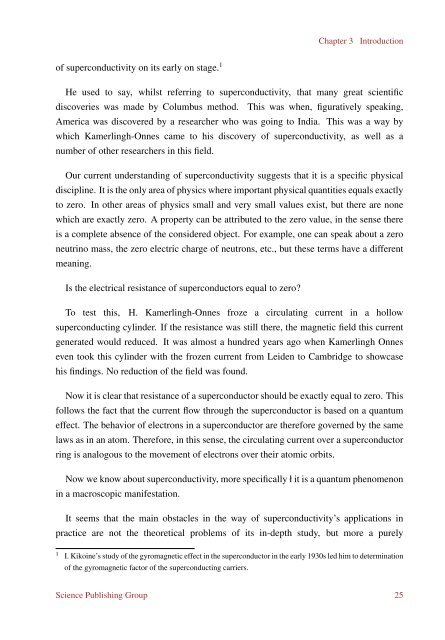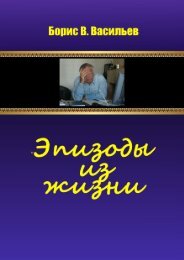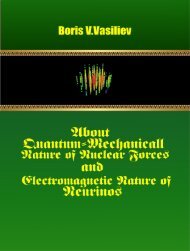978-1-940366-36-4_WholeBook
Boris V. Vasiliev Supercondustivity Superfluidity
Boris V. Vasiliev
Supercondustivity Superfluidity
You also want an ePaper? Increase the reach of your titles
YUMPU automatically turns print PDFs into web optimized ePapers that Google loves.
Chapter 3<br />
Introduction<br />
of superconductivity on its early on stage. 1<br />
He used to say, whilst referring to superconductivity, that many great scientific<br />
discoveries was made by Columbus method. This was when, figuratively speaking,<br />
America was discovered by a researcher who was going to India. This was a way by<br />
which Kamerlingh-Onnes came to his discovery of superconductivity, as well as a<br />
number of other researchers in this field.<br />
Our current understanding of superconductivity suggests that it is a specific physical<br />
discipline. It is the only area of physics where important physical quantities equals exactly<br />
to zero. In other areas of physics small and very small values exist, but there are none<br />
which are exactly zero. A property can be attributed to the zero value, in the sense there<br />
is a complete absence of the considered object. For example, one can speak about a zero<br />
neutrino mass, the zero electric charge of neutrons, etc., but these terms have a different<br />
meaning.<br />
Is the electrical resistance of superconductors equal to zero?<br />
To test this, H. Kamerlingh-Onnes froze a circulating current in a hollow<br />
superconducting cylinder. If the resistance was still there, the magnetic field this current<br />
generated would reduced. It was almost a hundred years ago when Kamerlingh Onnes<br />
even took this cylinder with the frozen current from Leiden to Cambridge to showcase<br />
his findings. No reduction of the field was found.<br />
Now it is clear that resistance of a superconductor should be exactly equal to zero. This<br />
follows the fact that the current flow through the superconductor is based on a quantum<br />
effect. The behavior of electrons in a superconductor are therefore governed by the same<br />
laws as in an atom. Therefore, in this sense, the circulating current over a superconductor<br />
ring is analogous to the movement of electrons over their atomic orbits.<br />
Now we know about superconductivity, more specifically ł it is a quantum phenomenon<br />
in a macroscopic manifestation.<br />
It seems that the main obstacles in the way of superconductivity’s applications in<br />
practice are not the theoretical problems of its in-depth study, but more a purely<br />
1 I. Kikoine’s study of the gyromagnetic effect in the superconductor in the early 1930s led him to determination<br />
of the gyromagnetic factor of the superconducting carriers.<br />
Science Publishing Group 25













